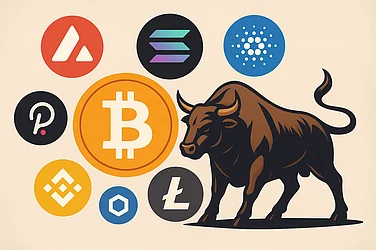For years, the financial world has been a tale of two cities. In one, you have the centuries-old, regulated world of traditional finance (TradFi), powered by fiat currencies. In the other, you have the fast-moving, decentralized world of crypto. The prevailing narrative has been one of conflict: a battle for the future of money.
This narrative is wrong.
The future is not a battle; it's a convergence. Fiat and crypto are not competing to the death; they are integrating out of necessity. Each system has what the other desperately needs to thrive in the modern era. This is the story of that great integration and the hybrid financial system it is creating.
The Two-Way Street: Why Each System Needs the Other
1. Why Traditional Finance Needs Crypto's Technology
The infrastructure of TradFi is old, slow, and expensive. It operates on a 9-to-5 schedule in a 24/7 world.
The Problem: International payments take days and involve high fees (via systems like SWIFT). Stock market settlements are not instant. The system is riddled with intermediaries.
Crypto's Solution: Blockchain offers an open, 24/7, and hyper-efficient "operating system" for finance. It enables instant settlement, programmable money, and the removal of costly middlemen. TradFi needs this technology to stay relevant.
2. Why Crypto Needs Traditional Finance's Trust and Scale
The world of pure crypto is volatile, complex, and lacks the trust and distribution needed for mass adoption.
The Problem: Extreme price volatility makes it unsuitable for daily commerce. A lack of regulatory clarity keeps mainstream capital on the sidelines. The user experience can be intimidating.
TradFi's Solution: The traditional financial system brings stability (via fiat-pegged stablecoins), a massive user base, regulatory frameworks, and trillions of dollars in liquidity. Crypto needs this infrastructure to become more than just a speculative asset class.
The 3 Key Bridges Being Built Right Now
This is not a theoretical future; the integration is already underway.
1. Stablecoins: Fiat Living on the Blockchain
Stablecoins like USDC are the most successful bridge ever built. They represent fiat currency (the trust and stability of the dollar) living on the rails of crypto (the speed and efficiency of the blockchain). They are the primary medium of exchange in the DeFi world.
2. Institutional Adoption: The Wall Street On-Ramp
When the world's largest asset manager, BlackRock, launches a spot Bitcoin ETF, the debate is over. Institutions are not just "investing" in crypto; they are building the regulated, high-security bridges for mainstream capital to flow into the digital asset ecosystem.
3. Central Bank Digital Currencies (CBDCs): Governments Join the Race
The ultimate sign of convergence is when governments themselves adopt the technology. CBDCs are a direct attempt by central banks to create a "TradFi" version of a digital currency, combining the authority of fiat with the efficiency of a blockchain.
Benefits of Combining Fiat and Cryptocurrencies
The union of fiat and crypto networks provides several advantages. It maximizes the world's access to finance, making the unbanked accessible through mobile-based crypto wallets yet remains fiat-dependent for compliant transactions. Cross-border payments become less expensive and faster when bridges are provided by digital assets, doing away with dependence on expensive middlemen like SWIFT.
For investors, TradFi Integration offers new diversification options for their portfolios. Fiat-currency-pegged stablecoins allow investors to hedge crypto volatility without sacrificing blockchain's efficiency. Traditional institutions benefit while using the growing popularity of digital assets to make them more relevant in a changing financial landscape.
Challenges in the Path of TradFi Integration
While promising, the union of fiat and cryptocurrencies is full of difficulties. There is no regulatory clarity, and governments everywhere have not been able to clarify how digital assets would be taxed, regulated, and classified. Cybersecurity threats, fraudulent activity, and money laundering make accepting a hybrid solution more challenging.
There is, naturally, the problem of stability. Cryptocurrencies are usually volatile, and that introduces uncertainty regarding their role in payments in the long term. Fiat currencies, on the other hand, face the type of inflationary pressures and over-reliance on central banks. Striking a balance in these systems suitably is critical to long-term integration.
Moreover, there are still technology challenges. Blockchain networks are still plagued by scalability issues, and the conventional banking infrastructure is resistant to immediate digital transformation. Alone, only through collaboration, creativity, and regulatory harmonization can TradFi Integration truly thrive.
The Rise of Central Bank Digital Currencies (CBDCs)
Perhaps the most convincing example of TradFi Integration is the issuance of CBDCs. Unlike decentralized cryptocurrencies, CBDCs are supported by government fiat electronic versions of fiat currency. China, India, and Sweden already have pilots or pilot implementations underway.
CBDCs aim to retain the convenience of cryptocurrencies without governments being out of the loop and without tipping financial systems into chaos. They can streamline payments, enhance cross-border trade, and reduce payment costs. Opponents argue that CBDCs will reduce privacy by giving governments more insight into individuals' transactions. Nevertheless, their adoption heralds a future reality: fiat and blockchain will merge.
Will Fiat and Cryptocurrencies Compete or Cooperate
The debate is inclined to polarize fiat and cryptocurrencies as rivals. But life is not as straightforward. Both systems are robust and weak in different ways, and rather than replacing one another, they will likely coexist. Fiat will be the official state money of governments and institutions, while cryptocurrencies will transform the usage, storage, and transfer of money.
With TradFi Integration, the two models can exist side by side. For instance, businesses can accept payments in crypto but convert them to fiat for stability. Investors can invest in fiat as a base while exploring crypto markets for higher returns. Governments can regulate digital assets without derailing the spirit of innovation.
This symbiosis is not coincidental but unavoidable with increasing demand for agile, transparent, and effective financial systems.
The Future of Money in a Hybrid System
In the future, the world will most likely be a mixture of fiat money and cryptocurrencies. Fiat banks will incorporate blockchain technology into their business, and crypto companies will work together with regulators to gain trust. Everyday users may not even realize there is a difference, as wallets, applications, and payment systems mix both money together seamlessly.
Money here is not defined by paper money or digital tokens but by convenience of access, trust, and effectiveness. TradFi Integration will ensure that neither fiat nor crypto will totally reign supreme but both will transition side by side to accommodate global demands.
Conclusion
The argument regarding the existence or otherwise of coexistence of fiat and cryptocurrencies has been relegated to the past. With CBDCs, growing institutional investment in crypto, and increasing consumer demand for efficient payment systems, the future is inevitable. TradFi Integration is not just a possibility but a necessity to building a more robust, inclusive, and innovative financial system.
Fiat provides the stability and legitimacy required for global business, while cryptocurrencies encourage technological advancement and economic freedom. They coexist to create the future of money—a future where coexistence, rather than competition, defines progress.





















